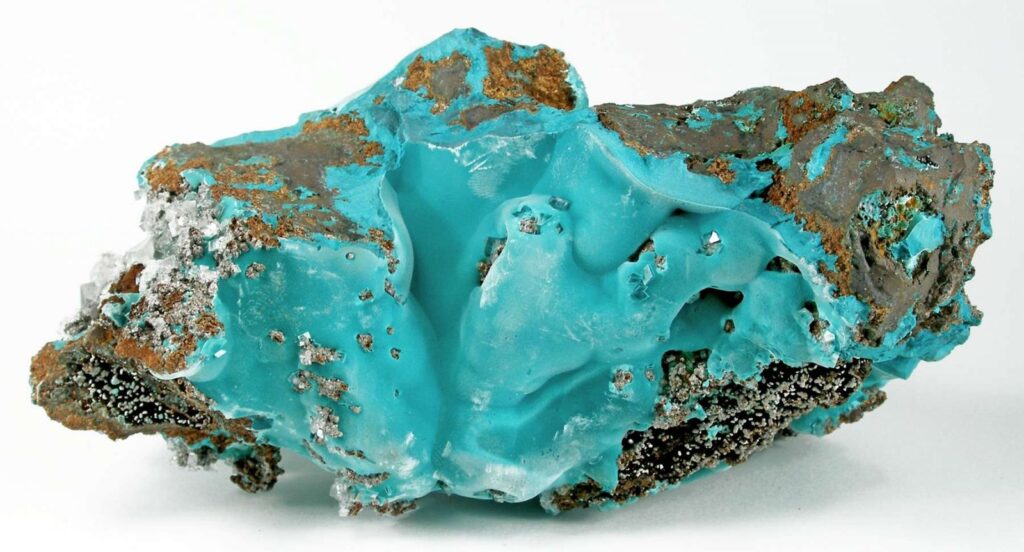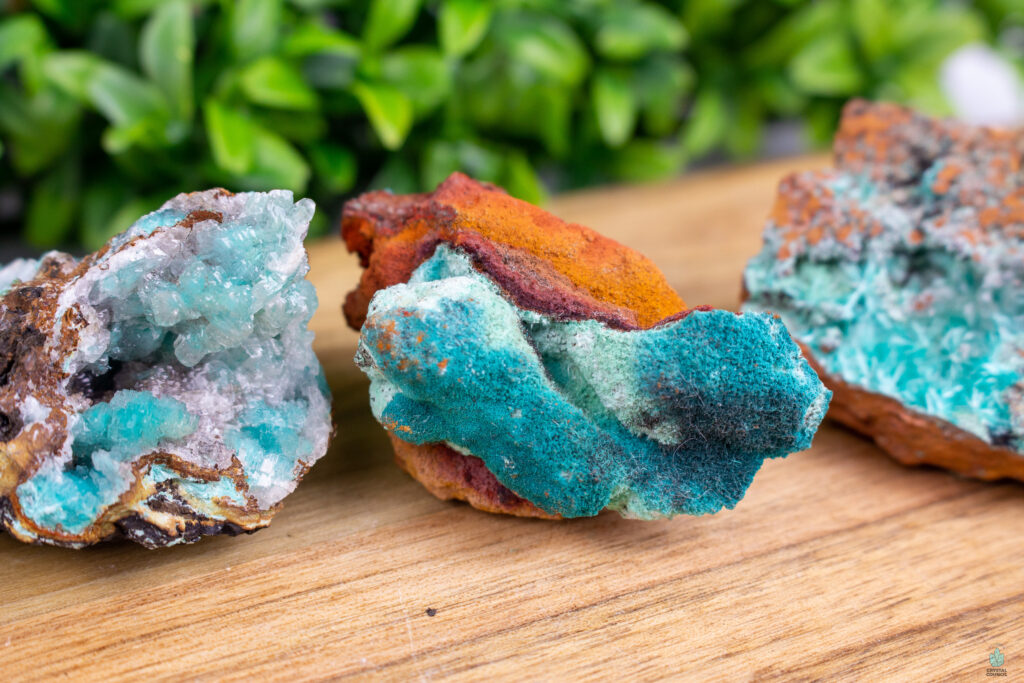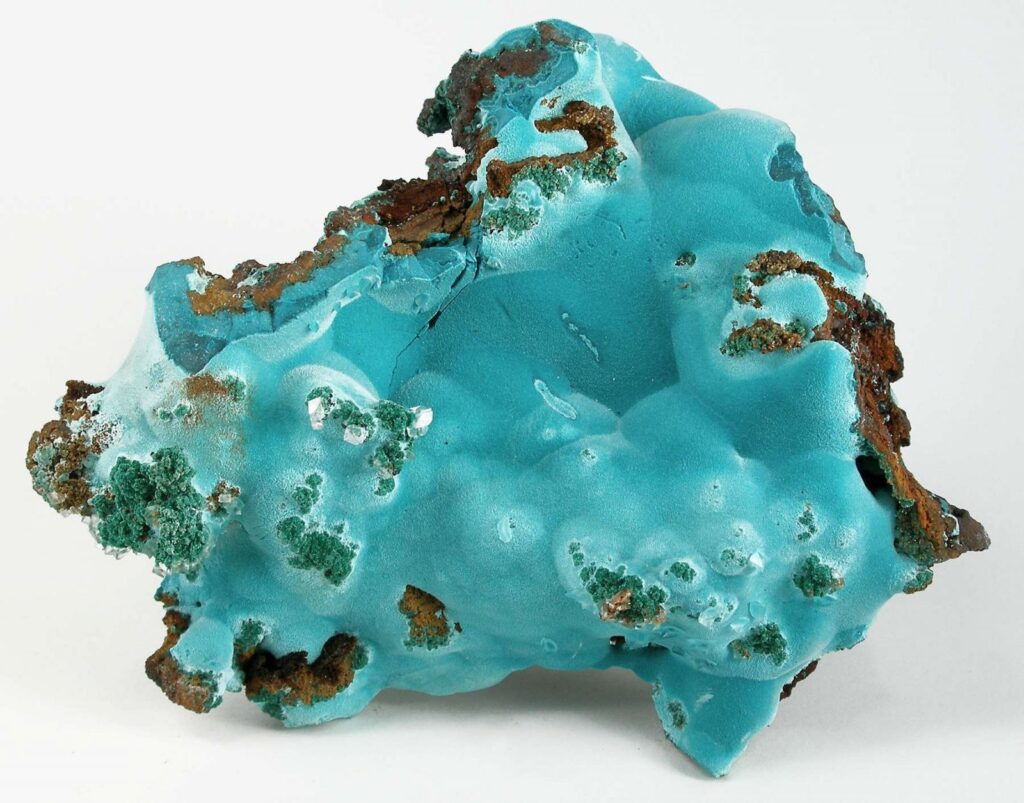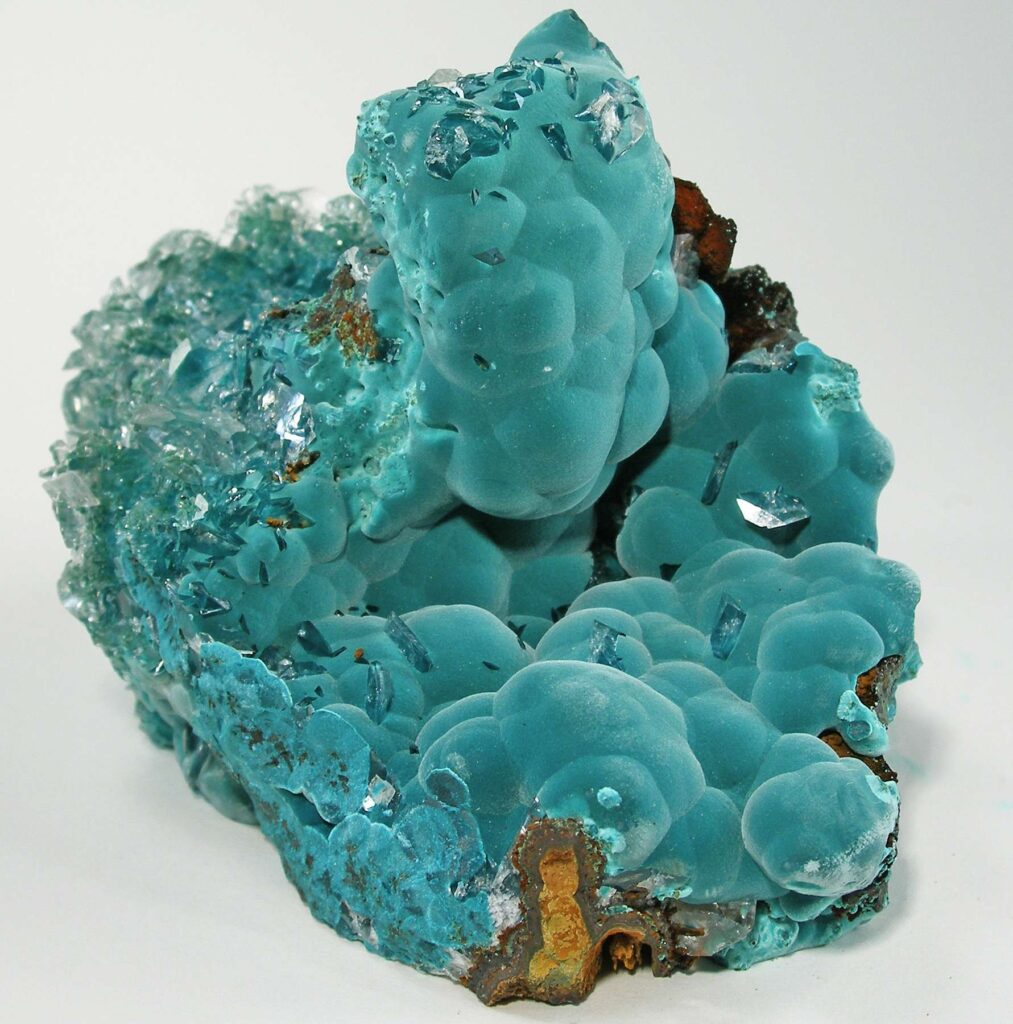Rosasite is a secondary mineral that typically forms in oxidized zones of copper-zinc ore deposits. It is chemically composed of copper zinc carbonate hydroxide, with the formula CuZnCO3(OH)2CuZnCO3(OH)2. This mineral is recognized for its attractive blue-green color and spherical, botryoidal, or fibrous crystal habit. Rosasite is closely related to malachite, aurichalcite, and azurite, sharing similar environments of formation and physical properties. It is relatively soft, with a Mohs hardness of around 4.5, and exhibits a vitreous to silky luster.

Rosasite was first discovered in the early 20th century. The mineral is named after the Rosas mine in Sardinia, Italy, where it was initially found. This mine is known for its rich deposits of various copper and zinc ores, making it a significant site for the study of such minerals. The discovery of rosasite added to the diversity of minerals known from this locality, highlighting the complex geochemical processes occurring in the oxidized zones of these ore deposits. The naming convention followed in mineralogy often links new minerals to their type locality (place of first description), which in the case of rosasite, commemorates the Rosas mine.
Physical and Chemical Properties of Rosasite

Chemical Formula and Structure
The chemical formula for rosasite is CuZnCO3(OH)2CuZnCO3(OH)2, which indicates that it primarily consists of copper, zinc, carbonate, and hydroxide ions. Structurally, rosasite belongs to the monoclinic crystal system. It features layers of carbonate ions covalently bonded to copper and zinc atoms, which are further linked by hydroxide groups. This structure results in the formation of dense, botryoidal aggregates rather than well-defined individual crystals.
Physical Properties
- Color: Rosasite typically displays a vibrant blue to green color, which can vary depending on the relative amounts of copper and zinc in the mineral. This coloration makes it quite distinctive and visually similar to minerals like malachite and azurite.
- Hardness: Rosasite has a Mohs hardness of about 4.5, which makes it relatively soft. It’s slightly harder than malachite but softer than many other common minerals. This level of hardness means it can be scratched by minerals such as apatite but not by a copper penny.
- Crystal Forms: While rosasite can crystallize in the monoclinic system, it is most commonly found in spherical aggregates known as botryoids. These botryoidal formations are made up of tightly packed, fibrous crystals that create a smooth, rounded surface. Rosasite can also form fibrous masses or be found lining cavities in host rocks, presenting a velvety appearance.
- Luster and Transparency: Rosasite typically exhibits a vitreous to silky luster, giving it a glossy look when light hits its surface. It can be translucent to opaque, which contributes to its depth of color and visual appeal.
- Cleavage and Fracture: Rosasite does not have a well-defined cleavage, and it generally fractures unevenly, displaying a sub-conchoidal fracture pattern.
- Specific Gravity: The specific gravity of rosasite is approximately 4.0, which is considered moderately high and reflects its metallic content.
These physical and chemical characteristics of rosasite not only define its appearance and the conditions under which it forms but also determine its suitability for various uses, including as a collector’s mineral and occasionally in jewelry, though its softness limits its wearability.
Notable Worldwide Occurrences of Rosasite

Rosasite is found in several notable locations around the world, often associated with the oxidized zones of copper and zinc deposits. Here are some of the most significant occurrences:
- Rosas Mine, Sardinia, Italy – The type locality for rosasite, where it was first identified. This mine is historically important and is known for its variety of copper and zinc minerals.
- Ojuela Mine, Mapimí, Durango, Mexico – A well-known mineral locality that produces exceptional specimens of rosasite with vibrant colors and excellent crystal forms. The rosasite from this mine often occurs with other secondary minerals such as malachite and azurite.
- Tsumeb Mine, Tsumeb, Namibia – Famous for its outstanding mineral diversity and quality, Tsumeb has produced fine rosasite specimens, often associated with other carbonate minerals.
- Bisbee, Arizona, USA – Known for its rich ore bodies, Bisbee has yielded fine rosasite specimens along with a suite of other copper-based minerals. The rosasite from Bisbee is noted for its rich green color and botryoidal habit.
- Kelly Mine, New Mexico, USA – Another significant U.S. locality for rosasite, where it is found in copper deposits alongside minerals such as smithsonite and hemimorphite.
Major Mining Locations and Their Output
While rosasite is not typically mined as a primary ore of either copper or zinc, its presence indicates the geochemical processes in play within specific mining locations and can contribute to understanding ore genesis in these areas. Most of the mining locations noted for rosasite are primarily extracting copper, zinc, or other metals, with rosasite being a secondary find. Here’s a brief overview of the major mining activities related to rosasite locations:
- Rosas Mine, Sardinia, Italy: Historically mined for zinc and lead, with copper as a secondary product. Although not active as a major mining operation today, it remains a classic locality for mineral collectors.
- Ojuela Mine, Mexico: This mine is still active and is famous among collectors for its variety of minerals, particularly lead and zinc ores, with rosasite as a notable byproduct.
- Tsumeb Mine, Namibia: Once one of the world’s greatest mining and mineralogical locations, it was primarily a lead-copper-zinc mine but is now closed. The specimens from Tsumeb, however, continue to circulate widely in the mineral collecting community.
- Bisbee, Arizona, USA: Primarily a copper mine, now mostly inactive but during its operational years, it was one of the largest copper sources in the world.
- Kelly Mine, New Mexico, USA: This location was an important source of smithsonite (zinc ore), with rosasite being a less common but still notable mineral find.
The output from these mines primarily focuses on their primary commodities, such as copper and zinc, with minerals like rosasite being valued mainly by mineral collectors rather than for their ore content.
Formation and Occurrence of Rosasite

Geologic Settings
Rosasite typically forms in the oxidized zones of copper and zinc ore deposits. These zones are areas where sulfide minerals have been altered by exposure to oxygen and water, leading to the formation of a variety of carbonate and hydroxide minerals. The typical geologic settings for rosasite include:
- Carbonate-hosted Ore Deposits: These deposits are often rich in lead, zinc, and sometimes copper. Rosasite forms here through the alteration of primary sulfide minerals such as sphalerite and chalcopyrite.
- Copper Porphyry Systems: In these large, disseminated copper deposits, rosasite can form in the upper, oxidized parts where the primary sulfides have been weathered.
- Skarn Environments: These are formed by the interaction of igneous intrusions with carbonate rocks, leading to the metamorphism and replacement of carbonates by ore minerals and their subsequent oxidation.
- Ancient Mine Workings and Tailings: Rosasite can also be found in the oxidized, weathered zones of old mines where exposed minerals undergo alteration due to atmospheric conditions.
Associated Minerals
Rosasite is commonly found in association with other secondary minerals that form under similar conditions. These include:
- Malachite: A common copper carbonate that often occurs with rosasite in oxidized copper deposits.
- Azurite: Another copper carbonate mineral, deeper blue than malachite, and frequently found alongside rosasite.
- Aurichalcite: A carbonate mineral that contains both zinc and copper, similar to rosasite but typically lighter in color.
- Smithsonite: A zinc carbonate that can form in similar environments as rosasite, often found in carbonate-hosted deposits.
- Hemimorphite: A hydrous zinc silicate that often occurs in the same oxidized zones as rosasite.
Typical Host Rocks
The host rocks for rosasite are typically limestones and dolostones, which are prone to interaction with mineralizing fluids that deposit copper and zinc. These carbonate rocks provide the necessary geochemical environment for the formation of rosasite and associated minerals during the process of mineralization and subsequent oxidation. The porous nature of these rocks allows for the circulation of mineral-rich fluids, which precipitate various carbonates and other minerals as they react with the host rock components.
In summary, rosasite forms through complex geochemical processes in specific types of ore deposits and is often associated with a characteristic suite of other secondary minerals. Its occurrence provides valuable clues about the geochemical history of the environments in which it is found.
Uses and Applications of Rosasite

Rosasite is not a commercially important mineral in terms of industrial applications, as its occurrence is generally limited and it does not contain economically significant amounts of metal to be mined for metal extraction. However, it does have several niche uses and applications, particularly in the fields of mineralogy, education, and aesthetics.
1. Collectors and Educational Use:
- Mineral Collecting: Rosasite is prized among mineral collectors due to its vibrant blue-green color and intriguing botryoidal and fibrous crystal forms. Its aesthetic appeal and relative rarity make it a desirable addition to mineral collections.
- Educational Tool: Rosasite can serve as an educational example in geological and mineralogical studies, illustrating the processes of mineral formation in oxidized zones of ore deposits. It helps in teaching about secondary mineralization and the geochemical cycles in ore deposit environments.
2. Jewelry and Decorative Stone:
- Lapidary Uses: Although rosasite is relatively soft with a Mohs hardness of around 4.5, which makes it susceptible to wear and abrasion, it can still be used in jewelry if properly set and cared for. It is typically used in pieces that are not subjected to rough wear, such as pendants and earrings, often in cabochon form to highlight its natural color and patterns.
- Decorative Items: Due to its attractive color and texture, rosasite can also be used in the creation of small decorative items such as carvings, inlays, and other ornamental objects. These uses take advantage of the mineral’s unique visual properties without subjecting it to the demands of daily wear.
3. Metaphysical Properties:
- In some circles, rosasite is believed to have metaphysical properties. It is sometimes used in crystal healing as a stone that can promote calmness, clarity of thought, and communication. These uses are not supported by scientific evidence but are popular in certain alternative healing and spiritual communities.
4. Research and Reference Material:
- Scientific Research: Rosasite, along with its associated minerals, can provide valuable insights into the geochemical processes at work in specific geological settings. Researchers study rosasite to understand more about mineral formation, the migration of mineralizing fluids, and the environmental conditions that lead to various types of mineral deposits.
- Reference Collections: Universities, museums, and geological institutions may keep specimens of rosasite for reference and study, aiding in the education of students and researchers in mineralogical and geological sciences.
Despite its limited industrial relevance, rosasite’s role in the fields of education, collection, and decorative arts, as well as its scientific value, underscores the broader cultural and scientific significance of minerals.




































